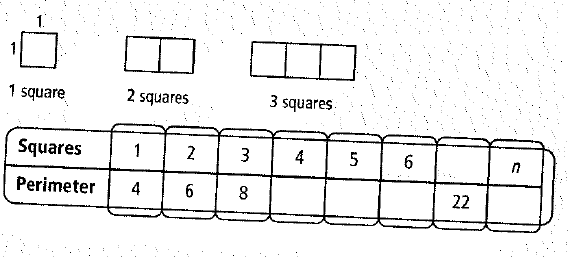
Concept explainers
For each diagram, find the relationship between the number of shapes and the perimeter of the figure they form. Represent this relationship using a table, words, an equation, and a graph.

To Fill: The table for perimeter for squares n.
Answer to Problem 2P

Explanation of Solution
Given information: 1 square has 4 units as perimeter, 2 squares has 6 units and 3 squares has 8 units and so on.
Calculation:
If we see the difference of y values they are increasing by 2 while x values are increasing by 1.
So, we can fill the next three boxes by increasing 2 from it’s previous value.

Now, let’s find the number of squares which has 22 as it’s perimeter.
Let’s continue the rule
| Number of squares | Perimeter |
| 7 | 16 |
| 8 | 18 |
| 9 | 20 |
| 10 | 22 |

Now, let’s find the rule.
Take two points on the table and find the rule
(1,4) (3,8)
Slope
Plug in this value into
It gives
Using (1,4)
Subtract both sides 2
The rule is
Here, we need to use variable ‘ n’ for ‘ x’.
So, the rule is
Chapter 4 Solutions
High School Math 2012 Common-core Algebra 1 Practice And Problem Solvingworkbook Grade 8/9
Additional Math Textbook Solutions
University Calculus: Early Transcendentals (4th Edition)
Intro Stats, Books a la Carte Edition (5th Edition)
Elementary Statistics: Picturing the World (7th Edition)
A First Course in Probability (10th Edition)
College Algebra (7th Edition)
Calculus for Business, Economics, Life Sciences, and Social Sciences (14th Edition)
- Let 2 A = 4 3 -4 0 1 (a) Show that v = eigenvalue. () is an eigenvector of A and find the corresponding (b) Find the characteristic polynomial of A and factorise it. Hint: the answer to (a) may be useful. (c) Determine all eigenvalues of A and find bases for the corresponding eigenspaces. (d) Find an invertible matrix P and a diagonal matrix D such that P-¹AP = D.arrow_forward(c) Let 6 0 0 A = -10 4 8 5 1 2 (i) Find the characteristic polynomial of A and factorise it. (ii) Determine all eigenvalues of A and find bases for the corresponding eigenspaces. (iii) Is A diagonalisable? Give reasons for your answer.arrow_forwardmost 2, and let Let P2 denote the vector space of polynomials of degree at D: P2➡ P2 be the transformation that sends a polynomial p(t) = at² + bt+c in P2 to its derivative p'(t) 2at+b, that is, D(p) = p'. (a) Prove that D is a linear transformation. (b) Find a basis for the kernel ker(D) of the linear transformation D and compute its nullity. (c) Find a basis for the image im(D) of the linear transformation D and compute its rank. (d) Verify that the Rank-Nullity Theorem holds for the linear transformation D. (e) Find the matrix representation of D in the standard basis (1,t, t2) of P2.arrow_forward
- (c) Let A = -1 3 -4 12 3 3 -9 (i) Find bases for row(A), col(A) and N(A). (ii) Determine the rank and nullity of A, and verify that the Rank-Nullity Theorem holds for the above matrix A.arrow_forward-(0)-(0)-(0) X1 = x2 = x3 = 1 (a) Show that the vectors X1, X2, X3 form a basis for R³. y= (b) Find the coordinate vector [y] B of y in the basis B = (x1, x2, x3).arrow_forwardLet A 1 - 13 (1³ ³) 3). (i) Compute A2, A3, A4. (ii) Show that A is invertible and find A-¹.arrow_forward
- Let H = {(a a12 a21 a22, | a1 + a2 = 0} . € R²x²: a11 + a22 (i) Show that H is a subspace of R2×2 (ii) Find a basis of H and determine dim H.arrow_forward2 5 A=1 2 -2 b=2 3 1 -1 3 (a) Calculate det(A). (b) Using (a), deduce that the system Ax = b where x = (x1, x2, x3) is consistent and determine x2 using Cramer's rule.arrow_forwardConsider the least squares problem Ax = b, where 12 -09-0 A 1 3 1 4 and b = (a) Write down the corresponding normal equations. (b) Determine the set of least squares solutions to the problem.arrow_forward
- The function f(x) is represented by the equation, f(x) = x³ + 8x² + x − 42. Part A: Does f(x) have zeros located at -7, 2, -3? Explain without using technology and show all work. Part B: Describe the end behavior of f(x) without using technology.arrow_forwardHow does the graph of f(x) = (x − 9)4 – 3 compare to the parent function g(x) = x²?arrow_forwardFind the x-intercepts and the y-intercept of the graph of f(x) = (x − 5)(x − 2)(x − 1) without using technology. Show all work.arrow_forward
 Algebra and Trigonometry (6th Edition)AlgebraISBN:9780134463216Author:Robert F. BlitzerPublisher:PEARSON
Algebra and Trigonometry (6th Edition)AlgebraISBN:9780134463216Author:Robert F. BlitzerPublisher:PEARSON Contemporary Abstract AlgebraAlgebraISBN:9781305657960Author:Joseph GallianPublisher:Cengage Learning
Contemporary Abstract AlgebraAlgebraISBN:9781305657960Author:Joseph GallianPublisher:Cengage Learning Linear Algebra: A Modern IntroductionAlgebraISBN:9781285463247Author:David PoolePublisher:Cengage Learning
Linear Algebra: A Modern IntroductionAlgebraISBN:9781285463247Author:David PoolePublisher:Cengage Learning Algebra And Trigonometry (11th Edition)AlgebraISBN:9780135163078Author:Michael SullivanPublisher:PEARSON
Algebra And Trigonometry (11th Edition)AlgebraISBN:9780135163078Author:Michael SullivanPublisher:PEARSON Introduction to Linear Algebra, Fifth EditionAlgebraISBN:9780980232776Author:Gilbert StrangPublisher:Wellesley-Cambridge Press
Introduction to Linear Algebra, Fifth EditionAlgebraISBN:9780980232776Author:Gilbert StrangPublisher:Wellesley-Cambridge Press College Algebra (Collegiate Math)AlgebraISBN:9780077836344Author:Julie Miller, Donna GerkenPublisher:McGraw-Hill Education
College Algebra (Collegiate Math)AlgebraISBN:9780077836344Author:Julie Miller, Donna GerkenPublisher:McGraw-Hill Education





